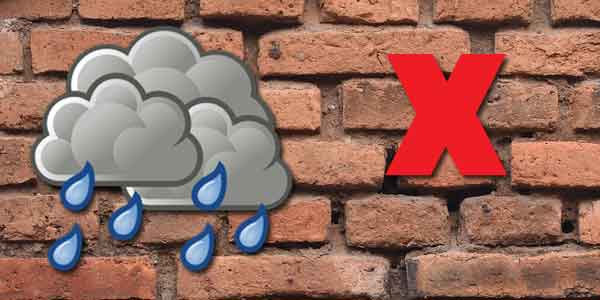The UK isn’t blessed with dry weather all year round. This means that many construction-based jobs must be tackled in the rain. If this is not possible, it means that projects can be delayed, and as a result take longer.
One big job that is performed on the outside of a property is pointing and re-pointing mortar joints. This is a job that can be made much more difficult in wet weather.
It is possible to carry out repointing in the rain, but this will depend on how bad the conditions are. If the rain is heavy, then you should avoid repointing, as it could prevent the mortar from setting. It could also cause the mortar to wash back out from the joints.
However, if the rain is light, then it should be possible to continue repointing. Crucially repointing should stop if the rain becomes heavy, and where possible you should try to protect any recent pointing from the rain.
Can you repoint wet bricks after it has rained?

After a period of heavy or prolonged rain, you might think you need to wait for the bricks to dry out, but this is not actually the case.
When repointing, you do need to ensure that your mortar sets correctly. This is reliant on several factors, including the right mortar mixture, but it is also dependent on the bricks themselves. Bricklayers will often dampen blocks and bricks before laying them to ensure that the mortar sets correctly and bonds well to the bricks.
So, if the bricks are wet when repointing, it is not a big issue. Not unless they are completely saturated, only then will they need to dry out slightly. The aim is to ensure that the mortar gets a good hold on the brickwork to create a solid finish. If the bricks are dry, they will take some of the moisture from the mortar. This can result in the mortar not setting correctly, eventually causing it to weaken.
When your bricks are wet, it will slow down the speed of absorption, keeping more moisture in the mortar. This will ensure that the chemical reaction within the mortar takes place correctly, leading to a solid finish.
What Happens if it Starts to Rain When Pointing?
When pointing, weather can play a big part in the finished job. For example, if it is too hot and dry, the mortar can dry out too quickly and leave a poor finish. Similarly, if it is too wet, this can also cause a range of problems.
If you want a solid mortar, and a perfect finish, it needs to set and cure. For this to occur, a chemical reaction takes place between the sand, cement, and water. However, if you increase the amount of water, the mortar will become too wet and it won’t set, this is the main problem you face when it starts to rain.
During heavy rain, the mortar can become saturated, and this leads to an imbalance in the ratio of cement, sand, and water. The mortar can eventually become too wet, which means that it can wash back out of the joints. Any mortar that remains won’t set correctly and will be too weak.
Furthermore, any mortar that washes out of the joint will run down the brickwork. This can set on the brickwork and cause it to look unsightly.
How Long Does Pointing Take to Dry?
Once you have finished pointing, you will then need to wait for it to dry. If you have mixed your mortar correctly, then it will reach around 60% of its strength in 24 hours. If the weather is dry and warm, then this can reduce to 12 hours.
Once dry, it will still take time to completely cure and reach its full strength. This can take around 28 days, but there are some factors that can impact the drying and curing time.
Air Flow – If it is windy, then this can result in moisture being stripped away from the mortar. This can cause the mortar to fail and not set correctly. However, this is usually less of an issue, unless it is combined with higher temperatures.
Temperature – Mortar will benefit from the right temperature to dry correctly. If the temperature is extremely cold, then this could cause moisture in the mix to freeze. If the temperature is extremely hot, then, this can cause any moisture to evaporate too quickly.
Both types of extreme weather can cause issues with the finished pointing. A nice mild/warm day would be ideal. No one wants to point in sub zero temperatures. But if the weather is cracking the flags, you probably want to avoid it too.
Mix Ratio – The speed at which your mortar dries, will depend on the mix ratio. This means that you need to create the right mix to ensure it dries and sets correctly. If you add too much water, it will take longer to dry, adding more sand will make it softer, and more cement will make it harder. The strength and ratio (sand/cement) of the mix will depend on the masonry it is applied to, but too much water is never a good option.
How Do You Protect Repointing if it Rains?
If you have started repointing and it begins to rain, then you need to protect the mortar as soon as possible. This will ensure that you provide the right protection to stop additional moisture from washing out the mortar.
To protect pointing from the rain, you will need to ensure that waterproof sheeting is placed over the brickwork. If the temperature is going to drop below freezing, you should use a layer of hessian insulation below the waterproof sheeting.
This will enable the mortar to remain protected, and it will also enable it to set and dry correctly, without freezing.
Conclusion
It is not recommended that you repoint in the rain. You might be able to carry out the task in light rain, but even then, you should do your best to prevent the mortar from becoming too wet. Once wet, it could wash out of the joints and leave your bricks looking untidy.
Therefore, the best approach is to ensure that you check the weather and repoint when it is dry. If it does rain, you should make sure that you protect your brickwork and mortar using waterproof sheeting. This will ensure that your mortar sets correctly and stands the test of time.



